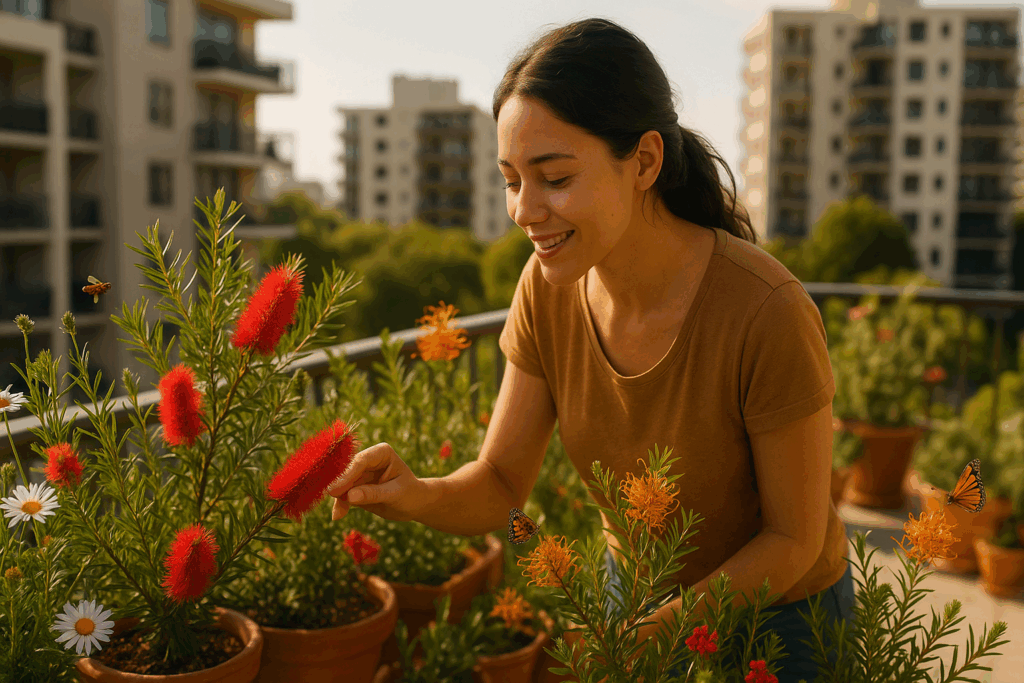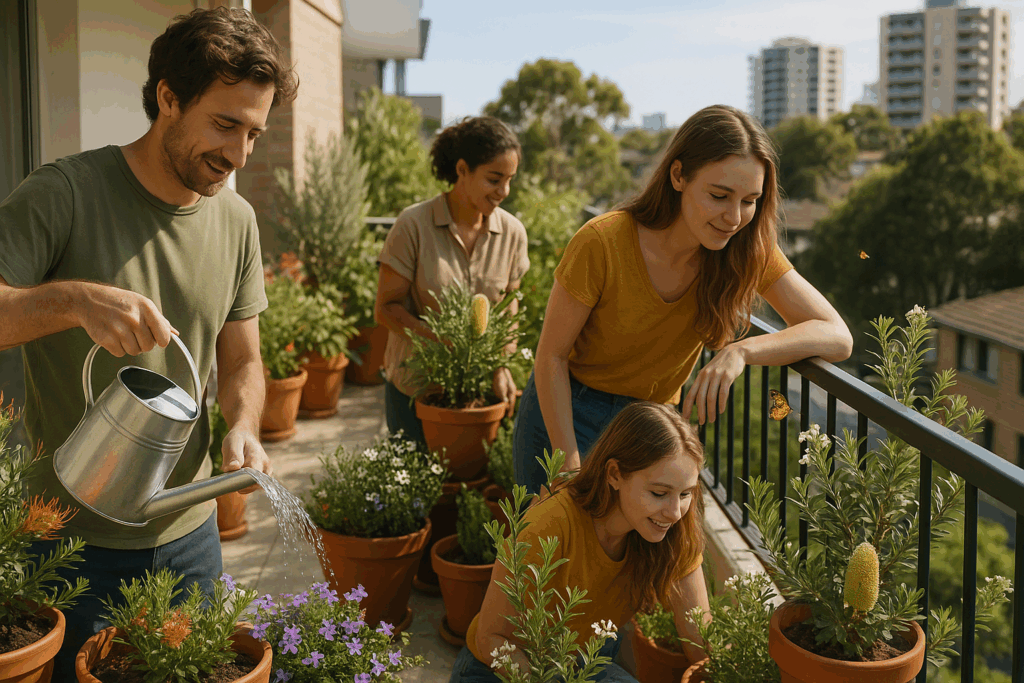Does the thought of living in an apartment mean giving up on helping local wildlife? It’s a myth worth rethinking.
Plenty of Australians love nature yet overlook how much a balcony can offer, as many assume they need a backyard to attract bees, butterflies, and birds.
There’s a better way. A thoughtfully arranged balcony garden becomes a genuine stopover for pollinators moving through urban areas. With just a few pots of Australian native plants, you’ll support local wildlife without the necessity of a backyard (and honestly, it’s easier than you think).
In this guide, we’ll walk you through plant lists, container setups, and wildlife-friendly arrangements. You’ll create a balcony garden that native bees and birds actually visit while keeping maintenance simple. Read on to learn how it all works.
Why Pollinators Rely on Your Balcony Garden
Pollinators need your balcony garden because urban development has eliminated most of their natural feeding and nesting sites. As Australian cities expand, native bees, butterflies, and other insects struggle to find the habitat they need to survive. So your balcony creates a vital rest stop in an otherwise concrete landscape.

You might be wondering how such a small space could possibly help. Let’s check it out.
- Habitat Loss Hits Hard: Urban expansion wipes out green spaces at an alarming rate. When these areas vanish, native bees and butterflies lose their food sources, too. That’s where your balcony garden comes in and delivers the flowers, nectar, and shelter that pollinators desperately need in cities.
- Creating Wildlife Corridors: Think of your balcony as one link in a chain. To a bee, it’s a resting stop between miles of concrete, a small refuel station before the next garden. Based on our observations, urban areas with more balcony gardens show increased native bee activity during flowering seasons.
- Native Plants Have the Edge: Australian native plants have evolved alongside local pollinators for millions of years. Today, their flower shapes, nectar, and bloom times mirror exactly what native bees and butterflies look for. Take grevilleas, for example; even a single potted plant can feed dozens of native bees each day.
And yes, every square metre of green space counts in concrete jungles. Your balcony contributes to urban biodiversity more than you’d expect.
Now that you understand the impact, here’s how to set up your space so wildlife badly wants to visit.
Setting Up Your Balcony Garden for Maximum Impact
Think you need fancy gear or deep pockets to grow a balcony full of life? Not at all. A few smart moves can bring in bees, birds, and butterflies without the fuss or expense. Even a small balcony can become a vibrant little ecosystem with the right setup.

Here’s a five-step setup that saves time, space, and money while doing the job beautifully.
- Choose the Right Containers: You’ll want terracotta pots for native plants because they breathe and prevent waterlogging. If you prefer something lighter, plastic planters work too, as long as drainage is sorted. Whichever you choose, aim for pots at least 25 cm deep so roots have space to grow.
- Map Your Sun and Shade: Start by watching how the sun hits your balcony throughout the day. Once you know your light patterns, you’ll see that most native plants do better in the softer morning light than in the strong afternoon glare. And if your landlord isn’t keen on drilling, don’t worry, you can simply use freestanding plant stands to keep things flexible.
- Set Up Simple Watering: To save time and effort, grab self-watering pots with built-in reservoirs. They feed water up through the soil gradually, so you’re not stuck watering every single day. Through our hands-on experience, we’ve found that self-watering systems reduce maintenance time by half while keeping native plants healthier.
- Create Vertical Layers: When your basics are ready, start building upwards. The idea is to place low growers near the base, mid-height shrubs in the centre, and taller plants at the back or sides. This vertical setup makes your balcony feel lush while giving pollinators more spots to feed.
- Add Water and Shelter Elements: In corners and gaps, tuck shallow water dishes for birds and bees alongside twigs for shelter. These additions cost almost nothing but make your garden far more welcoming. After all, wildlife needs more than just flowers to stick around.
Set this up once, and your balcony practically runs itself while wildlife keeps showing up.
Native Plants for Balcony Gardens
You’ve got your setup sorted. Now comes the fun part: choosing plants that pollinators and birds actually want to visit. And you don’t need a degree in botany for this. Just stick with Australian natives, which give you the best results because local wildlife already knows and seeks them out.

We’ve grouped them into three categories to make choosing easier.
Nectar-Rich Flowers That Pollinate Plants Love
Imagine this: a balcony garden alive with bees weaving between bursts of colour. These native blooms make it happen. For example, Grevillea ‘Poorinda Royal Mantle’ packs bright tubular flowers into 30 cm pots, drawing pollinators within minutes. And in shaded spots, native violets keep the colour lasting, while Westringia and Scaevola add soft white and purple blooms that butterflies can’t resist.
Small Trees for Birds and Shade
Want to attract honeyeaters and provide shade? Lilly pilly dwarf varieties produce berries that birds love in pots 40cm deep. Then consider Banksia ‘Birthday Candles’, which stays compact with nectar-rich spikes, and bottlebrush ‘Little John’ brings honeyeaters with red flowers.
Ground Covers and Foliage for Shelter
The final layer of your balcony ecosystem comes from low-growing shelter plants. For instance, Myoporum parvifolium spreads with white flowers and creates safe spaces for insects. You can also include native grasses like Lomandra, which provide hiding spots between pots, while dichondra repens spills over edges in part shade.
After trying dozens of native species, we’ve found these adapt best to balcony conditions. One more tip: nurseries specialising in Australian native plants offer better advice than large retail chains.
Your Next Steps as an Urban Wildlife Guardian
Urban living doesn’t mean abandoning nature. Too many apartment dwellers assume they can’t help local wildlife, but your balcony offers genuine opportunities. With the right plants and a simple setup, you can create a meaningful stopover for pollinators and birds moving through Australian cities.
You now know why balcony gardens help pollinators, how to set up containers and watering systems, and which Australian native plants work best in small spaces. From Grevilleas to ground covers, these species attract bees, butterflies, and birds while requiring minimal maintenance once established.
Ready to start? Visit Eco4theWorld for more sustainability tips that create real environmental impact from small actions. Your balcony can become part of Australia’s urban wildlife network today.
